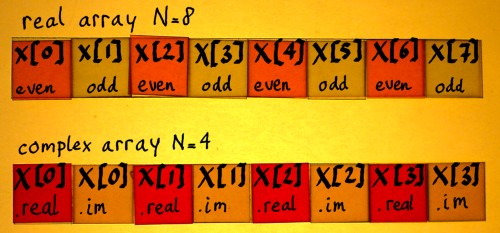
'Real' FFT implementation
The previous page illustrated how you can feed real signals in both
real and imaginary FFT inputs and later extract the two spectra from
the FFT output. The technique is simple, but I want more: feed one
real signal into an FFT with length N/2. That is even more convenient
in applications.
The real signal must be split in two parts, one part fed into the
real FFT input, the other in the imaginary input. The obvious way to
split is in even and odd phase. The whole FFT method is based on phase
decomposition, therefore the method itself can be applied to compensate
for the effects of such splitting.
Now is a good moment to introduce the complex datatype, and compare
this with the even/odd sequence in a real vector. In C, a complex
datatype is
nothing more than a struct with two members, real and imaginary
variables of type float or double, whatever is normally used for the
real vectors.
 |
With the complex datatype, real and imaginary parts are stored
in one contiguous array, interleaved in way
similar to the sequence of even and odd in a real array. Storing
complex numbers in this fashion is both convenient and efficient. Most
authors do it this way. I was
not so much convinced, until I refactored my FFT routines to
datatype complex. They became twice as fast, probably through GNU CC's
vector optimizations.
Using the complex datatype, one can no longer feed a real signal in
straightaway, like I did on all the preceding pages. But since we are
now heading for 'real' FFT, we are going to profit from the new
arrangement. A real array can be dereferenced as is, or it can be
dereferenced as a
complex array of half the length. For this to work, it suffices to
declare a pointer of type complex and have it point to the real array,
using a regular typecast.
|
t_complex *complexarray = (t_complex *)realarray; |
One and the same array can now be dereferenced in two manners:
realarray[n], 0<=n<N
complexarray[n].real and complexarray[n].im, 0<=n<N/2
If we process the real array with a complex FFT of framesize N/2,
using the complex datatype, the even phase goes into the real input and
the odd phase into the imaginary input automatically. Let us have a
look at what we are actually feeding in. Here is an example of a cosine
with fundamental frequency, and it's even and odd phase drawn as
separate half-length vectors:
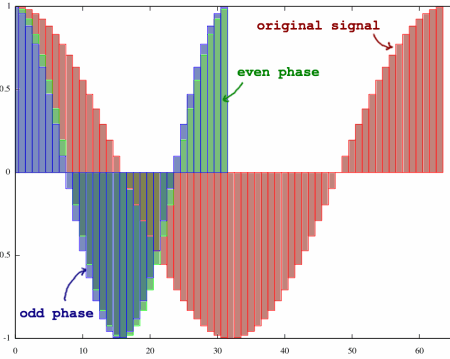 |
The even phase represents the original vector downsampled with a
factor two. The odd phase is downsampled as well. In addition to
that, it has a phase-shift which relates to the one-sample timeshift
in the original. What happens when
downsampling a signal? All frequencies are doubled, thereby folding
negative frequencies precisely over the positive frequencies range and
vice
versa. So we probably have aliases all over the place. All in all, our
task is
now much more complicated than extracting spectra of normal input
vectors, like it was done on the previous page.
Let us take a closer look at phase decomposition for the moment.
Below, I have tried to create an impression of a sinusoid decomposed
into even and odd phase. You see the individual phases, not yet
downsampled. It is a representation of what each phase contains, if
they would exist separately. Because every other sample is set to zero,
extra frequencies arise. These are not aliases but images. That is the
upsample-counterpart of the aliases. The isolated phases look like
upsampled vectors, with all these zeros in them. When we take these
zeroed components away and reduce the vectors to half length, the
images are gone. But take a close look at the
shape of the images: they have opposite sign.
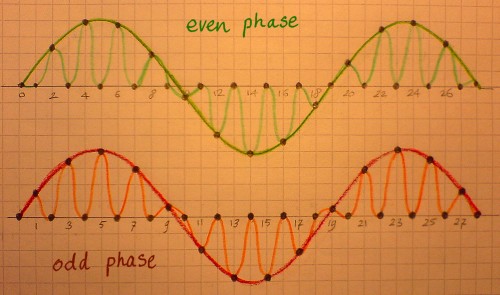 |
This is a very comfortable phenomenon. It means that aliases,
introduced by downsampling the two phases with factor 2, will propagate
through the transform in such a way that their spectrum coefficients
can later cancel each other. This aspect of phase decomposition is
crucial for Fast Fourier Transform in general, and also for Wavelet
Transform.
I have plotted an example of such separated but not yet downsampled
even and odd phases, fed into real and imaginary input of a normal
complex FFT. You see the even phase transformed as real coefficients
and the odd phase as imaginary coefficients. The image frequencies,
those appearing in the middle of the plot, have opposite signs indeed.
This is caused by the one-sample shift of the odd phase, and not by the
fact that the odd phase went into the imaginary input.
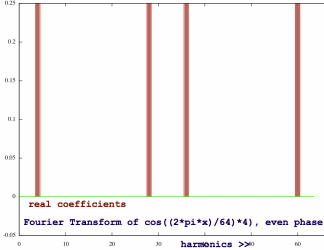 |
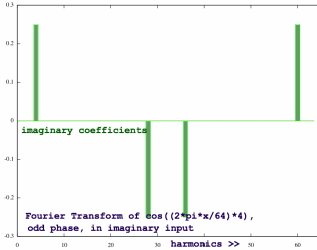 |
But we are going to really downsample these phases, take away every
other sample and make half-length vectors. These vectors are fed into
real and imaginary input of a half-length complex FFT. Of course, this
will result in half-length spectra as well. We have to split these
spectra, and this can be done using the simple technique that was
described on the previous page. I have done an example with split
spectra of the same cosine of periodicity 4:
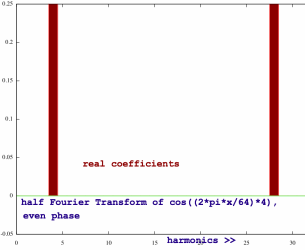 |
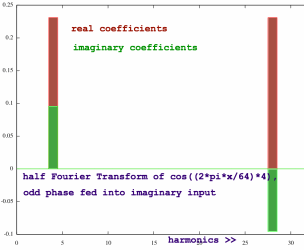 |
In the even phase's spectrum, the coefficients for the 4th harmonic
and it's negative counterpart 28 show up. This is what I would expect:
the vector was downsampled, but it was also analysed with a halfsize
FFT. For the odd phase, things are less straightforward. It had this
one-sample shift, and further it was fed in the imaginary input, so
it's spectrum had a rotation over pi/2 radian. This rotation is already
compensated in the splitting routine, so you do not see this in the
output. What you do see in the output, is the one-sample shift effect.
Maybe you have seen the spectrum plots of Kronecker delta's on my
page FFT Output. The
plots showed how a one-sample timeshift of a signal effectuates complex
multiplication of the spectrum with the fundamental frequency of the
transform. This spectral effect can be annulled by complex
multiplication in the inverse direction. I have done this on the odd
spectrum output, with the following result:
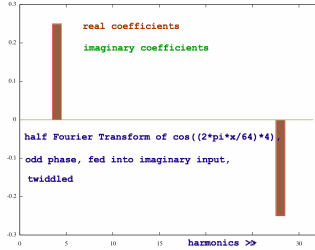 |
Now we have only real parts left. The negative frequency
coefficients in the even and odd phase spectra have opposite sign, as I
hoped for. If we now simply add both spectra, we get:
 |
This could be the end result, if you are happy with a 'halfcomplex'
spectrum, in which the conjugates are not present. The last actions,
complex multiplication off the odd spectrum and summing the spectra,
are very similar to a regular twiddle&add/subtract stage in an FFT,
only we did not subtract anything because we do not have the negative
frequencies part of the output.
I hope that you now feel real FFT is a piece of cake. Below is code
for a combined process of splitting even/odd phase spectra and
twiddle/add. You could insert code like this after a half-size complex
FFT which analysed even/odd phase. Like on the previous page, I leave
out the multiplication with 0.5 and do normalisation factor 0.5/N in
the forward transform. Pay special attention to the indexing: when
casting a real array to type complex, all indexing must be divided by
two.
// last real fft stage processes the mixed spectrum output of N/2 complex FFT // all computations done in-place // framesize relates to the size of the complete real signal vector // *twiddle relates to table with e-i2pi*n/framesize void lastrealstage(double *datareal, t_complex *twiddle, unsigned int framesize) { unsigned int n, f=framesize>>1; double evenreal, evenim, oddreal, oddim; // temp variables t_complex *data = (t_complex *)datareal; // cast the pointer for(n=framesize>>2; n; n--) // include the 'half-Nyquist' point { evenreal = data[n].real + data[f-n].real; // split the spectra evenim = data[n].im - data[f-n].im; oddreal = data[n].im + data[f-n].im; oddim = data[f-n].real - data[n].real;
} evenreal = data[0].real; data[0].real = (data[0].real + data[0].im) * 2.; // double DC value data[0].im = (evenreal - data[0].im) * 2; // double Nyquist and store next to DC } |
It is funny that all we have done is: splitting spectra, twiddling,
and summing spectra again. However there is a big difference in the
ways the spectra were merged: in the complex FFT they were summed out
of phase, and the last time, where the aliases were killed, they were
summed in-phase. Is it now possible to split the in-phase summed
spectra again, and go for an inverse FFT? Well, it is normally easier
to create aliases than to get rid of them. So I would think that this
must be possible. Surprisingly, it can even be done with almost the
same operations. We have to twiddle the other way round now, which
means flipping the sign of the imaginary twiddle factor. And where we
summed the even and odd spectra, we must now subtract. We can re-use
the code, with these small adaptations:
// first stage of real inverse FFT // all computations done in-place // framesize relates to the size of the complete real signal vector // *twiddle relates to table with e-i2pi*n/framesize void firstrealinvstage(double *datareal, t_complex *twiddle, unsigned int framesize) { unsigned int n, f=framesize>>1; double evenreal, evenim, oddreal, oddim; // temp variables t_complex *data = (t_complex *)datareal; // cast the pointer for(n=framesize>>2; n; n--) // include the 'half-Nyquist' point { evenreal = data[n].real + data[f-n].real; evenim = data[n].im - data[f-n].im; oddreal = data[n].im + data[f-n].im; oddim = data[f-n].real - data[n].real;
} evenreal = data[0].real; data[0].real = (data[0].real + data[0].im); // DC data[0].im = (evenreal - data[0].im); // store Nyquist next to DC } |
Writing the code like this, I wanted to highlight how close it is to
the forward version. However the variable names are not precisely to
the point anymore, because of the in-phase/out-of-phase difference and
the reversed order of operations. You could say that real and imaginary
part of the odd phase have swapped their names, anticipating their
rotation over pi/2 radians. Below is a version in neutral terms, that
can go both ways:
// first/last twiddle&add/subtract stage of bidirectional real fft // framesize relates to the size of the complete real signal vector // *twiddle relates to table with e-i2pi*n/framesize // invert=false for forward direction, invert=true for inverse direction void realbifftstage(double *datareal, t_complex *twiddle, unsigned int framesize, bool invert) { unsigned int n, halfNminusn; double realsum, realdiff, imsum, imdiff; // temp variables double twiddlereal, twiddled1, twiddled2; // temp variables t_complex *data = (t_complex *)datareal; // cast the pointer for(n=halfNminusn=(framesize>>2); n; n--, halfNminusn++) { realsum = data[n].real + data[halfNminusn].real; realdiff = data[n].real - data[halfNminusn].real; imsum = data[n].im + data[halfNminusn].im; imdiff = data[n].im - data[halfNminusn].im; if(invert) twiddlereal = -twiddle[n].real; else twiddlereal = twiddle[n].real; twiddled1 = twiddlereal * imsum + twiddle[n].im * realdiff; twiddled2 = twiddle[n].im * imsum - twiddlereal * realdiff; data[n].real = realsum + twiddled1; data[n].im = imdiff + twiddled2; data[halfNminusn].real = realsum - twiddled1; data[halfNminusn].im = twiddled2 - imdiff; } double data0real = data[0].real; // temp variable data[0].real = (data[0].real + data[0].im); // DC data[0].im = (data0real - data[0].im); // store Nyquist coefficient next to DC if(!invert) { data[0].real *= 2; // double DC and Nyquist in forward transform data[0].im *= 2; } } |
A couple of remarks remain to be made about the halfcomplex
spectrum.
It does not contain the conjugates, which is generally not really an
omission since they do not bear unique information. If needed, we can
always compute the conjugates and install the complete spectrum in a
bigger array. However if we do not, there is always this nasty Nyquist
point to be placed somewhere. The Nyquist frequency bin resides just
beyond the half-length complex vector, as it has index N/2. For the
sake of compatibility, I have placed the Nyquist coefficient in the
imaginary part of index[0], like it is traditionally done.
Since both DC and Nyquist have no imaginary part, they can live
together in one complex struct. However, it is a dangerous liason.
Imagine you start doing complex multiplications with the spectrum
coefficients, while forgetting about the status aparte of bin 0...
For an impression of the format, I plotted the halfcomplex Fourier
Transform of a familiar input type. It is clear that the silly appendix
on the left should in fact be a real part at the right side of the
spectrum, but there was no room for it.
 |
Finally, I have some comments on the normalisation or output
magnitude of a halfcomplex spectrum. Because the conjugates are not
represented, you see only half of the correlation: the correlation with
the positive frequencies. But DC and the Nyquist frequency have no
conjugates and I have them fully represented in the halfcomplex
spectrum. For spectrum manipulations involving multiplication, this
need not be a problem, because such alterations are proportional. But
when using the halfcomplex spectrum for analysis purposes, the unique
character of the zero bin must be reminded. Of course, one could
structurally reduce DC and Nyquist to half it's magnitude in the
forward transform and compensate in the inverse, but this could invoke
confusion just as well.
For comparison, here is the full complex spectrum of the same
Kronecker delta once more:
 |